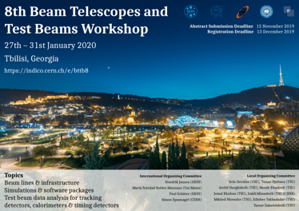Speaker
Description
Sensors based on ultrapure single crystal CVD diamonds have been operated in the Precision Proton Spectrometer (PPS) of the CMS experiment during the LHC Run 2 (2016-2018). Such sensors were used for the timing system of PPS and were hosted in the Roman Pots (RPs), movable devices allowing to bring the hosted detector inside the LHC beam pipe, at few millimeters from the beams. The sensors were exposed to an highly non uniform proton irradiation field, with a fluence peaking at about $\sim$5$\cdot$10$^{15}$ p/cm$^2$ ($\sim$2$\cdot$10$^{15}$ neq/cm$^2$). Dismounted at the end of LHC Run 2, they were tested in May in the T24 test beam line of DESY (Hamburg), with electrons with energy in the range 4-6 GeV. Data were acquired with a fast sampler (SAMPIC chip, 6.4 Gsa/s) and an offline procedure was developed to merge them with the information of the EUDET telescope. During that campaign synchronization was made via the Trigger Logic Unit (TLU) of the telescope, providing trigger and event number to the SAMPIC board. The resulting 4D information was crucial to determine the radiation damage, both in terms of its localization and of effect on the sensors performance. A description of the sensor and setup will be presented, along with the results obtained.




